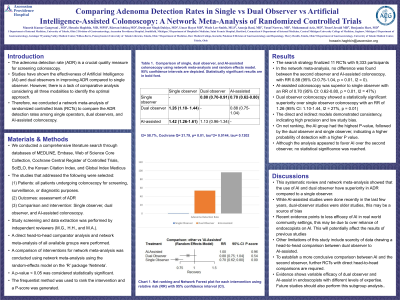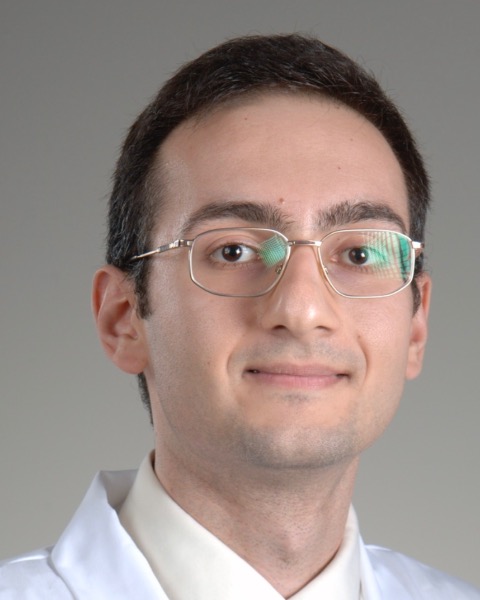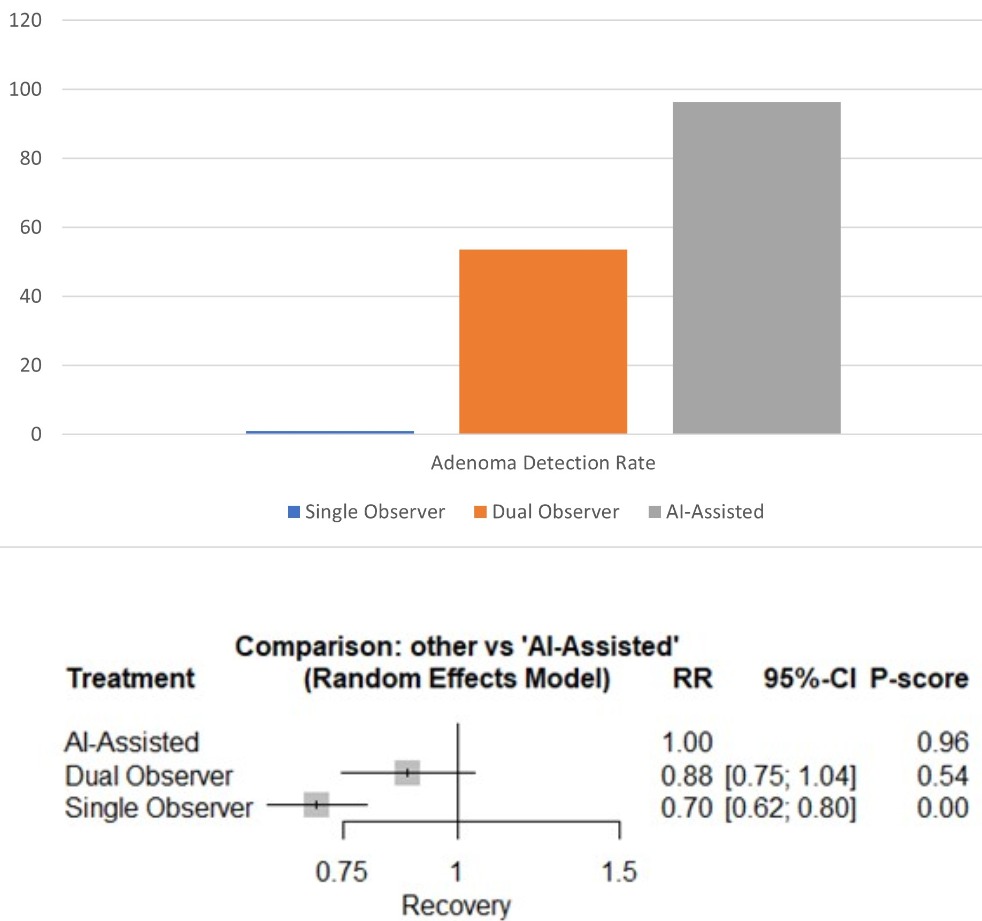Monday Poster Session
Category: Colorectal Cancer Prevention
P1780 - Comparing Adenoma Detection Rate (ADR) in Single vs Dual Observer vs Artificial Intelligence-Assisted Colonoscopy: A Network Analysis of Randomized Controlled Trials
Monday, October 23, 2023
10:30 AM - 4:15 PM PT
Location: Exhibit Hall

Has Audio

Hossein Haghbin, MD
Ascension Providence Hospital
Southfield, Michigan
Presenting Author(s)
Manesh Kumar Gangwani, MD1, Hossein Haghbin, MD2, Rizwan Ishtiaq, MD3, Dushyant Singh. Dahiya, MD4, Umar Hayat, MD5, Wade M.. Lee-Smith, MLS1, Anooja Rani, 6, Yusuf Nawras, 1, Muhammad Aziz, MD1, Toseef Javaid, MD1, Benjamin Hart, MD, PhD7
1University of Toledo, Toledo, OH; 2Ascension Providence Hospital, Southfield, MI; 3Academic Hospitalist, St. Francis Hospital, Hartford, CT; 4University of Kansas School of Medicine, Kansas City, KS; 5Geisinger Wyoming Valley Medical Center, Wilkes-Barre, PA; 6Dow University of Health Sciences, Karachi, Sindh, Pakistan; 7University of Michigan, Ann Arbor, MI
Introduction: The adenoma detection rate (ADR) is a crucial quality measure for screening colonoscopy. Recent randomized controlled trials have shown the effectiveness of Artificial Intelligence (AI) and second observers in improving ADR. However, there is a lack of comparative analysis considering all three modalities to identify the optimal approach. Therefore, we conducted a network meta-analysis of randomized controlled trials (RCTs) to compare the ADR detection rates among single operators, second observers, and AI.
Methods: MEDLINE, Embase, Web of Science Core Collection, Cochrane Central Register of Controlled Trials, SciELO, the Korean Citation Index, and Global Index Medicus were systematically searched from inception through April 2023. Network (direct + indirect) meta-analysis was performed using a random effects model and a frequentist approach. The risk ratio (RR) with a 95% confidence interval (CI) was calculated.
Results: A total of 1,119 articles were screened, and eventually, 11 RCTs with 9,333 participants were included in the analysis.
In the network meta-analysis, no statistical difference was found between the second observer and AI-assisted colonoscopy, with RR 0.88 (95% CI: 0.75-1.04, p = 0.01, I2 = 0). However, a significant statistical difference was observed between the single observer and AI-assisted colonoscopy, favoring the AI-assisted group, with an RR of 0.70 (95% CI: 0.62-0.80, p = 0.01, I2 = 47%). Similarly, a significant statistical difference was noted between the second observer group and the single observer group, with an RR of 1.26 (95% CI: 1.10-1.44, I2 = 27%, p = 0.01). The model exhibited a heterogeneity of 58.7%. The direct and indirect models demonstrated consistency, indicating high precision and low study bias.
On net ranking, the AI group had the highest P-value, followed by the second observer and single observer, indicating a higher probability of detection with a higher P value. Although the analysis appeared to favor AI over the second observer, no statistical significance was reached.
Discussion: The use of artificial intelligence (AI) and a second observer demonstrates superiority in ADR compared to a single observer. However, to establish a more conclusive comparison between AI and the second observer, further randomized controlled trials (RCTs) with direct head-to-head comparisons are required.

Disclosures:
Manesh Kumar Gangwani, MD1, Hossein Haghbin, MD2, Rizwan Ishtiaq, MD3, Dushyant Singh. Dahiya, MD4, Umar Hayat, MD5, Wade M.. Lee-Smith, MLS1, Anooja Rani, 6, Yusuf Nawras, 1, Muhammad Aziz, MD1, Toseef Javaid, MD1, Benjamin Hart, MD, PhD7. P1780 - Comparing Adenoma Detection Rate (ADR) in Single vs Dual Observer vs Artificial Intelligence-Assisted Colonoscopy: A Network Analysis of Randomized Controlled Trials, ACG 2023 Annual Scientific Meeting Abstracts. Vancouver, BC, Canada: American College of Gastroenterology.
1University of Toledo, Toledo, OH; 2Ascension Providence Hospital, Southfield, MI; 3Academic Hospitalist, St. Francis Hospital, Hartford, CT; 4University of Kansas School of Medicine, Kansas City, KS; 5Geisinger Wyoming Valley Medical Center, Wilkes-Barre, PA; 6Dow University of Health Sciences, Karachi, Sindh, Pakistan; 7University of Michigan, Ann Arbor, MI
Introduction: The adenoma detection rate (ADR) is a crucial quality measure for screening colonoscopy. Recent randomized controlled trials have shown the effectiveness of Artificial Intelligence (AI) and second observers in improving ADR. However, there is a lack of comparative analysis considering all three modalities to identify the optimal approach. Therefore, we conducted a network meta-analysis of randomized controlled trials (RCTs) to compare the ADR detection rates among single operators, second observers, and AI.
Methods: MEDLINE, Embase, Web of Science Core Collection, Cochrane Central Register of Controlled Trials, SciELO, the Korean Citation Index, and Global Index Medicus were systematically searched from inception through April 2023. Network (direct + indirect) meta-analysis was performed using a random effects model and a frequentist approach. The risk ratio (RR) with a 95% confidence interval (CI) was calculated.
Results: A total of 1,119 articles were screened, and eventually, 11 RCTs with 9,333 participants were included in the analysis.
In the network meta-analysis, no statistical difference was found between the second observer and AI-assisted colonoscopy, with RR 0.88 (95% CI: 0.75-1.04, p = 0.01, I2 = 0). However, a significant statistical difference was observed between the single observer and AI-assisted colonoscopy, favoring the AI-assisted group, with an RR of 0.70 (95% CI: 0.62-0.80, p = 0.01, I2 = 47%). Similarly, a significant statistical difference was noted between the second observer group and the single observer group, with an RR of 1.26 (95% CI: 1.10-1.44, I2 = 27%, p = 0.01). The model exhibited a heterogeneity of 58.7%. The direct and indirect models demonstrated consistency, indicating high precision and low study bias.
On net ranking, the AI group had the highest P-value, followed by the second observer and single observer, indicating a higher probability of detection with a higher P value. Although the analysis appeared to favor AI over the second observer, no statistical significance was reached.
Discussion: The use of artificial intelligence (AI) and a second observer demonstrates superiority in ADR compared to a single observer. However, to establish a more conclusive comparison between AI and the second observer, further randomized controlled trials (RCTs) with direct head-to-head comparisons are required.

Figure: Net rank for intervention and comparison of study intervention using relative risk on (RR) on network-analysis.
Disclosures:
Manesh Kumar Gangwani indicated no relevant financial relationships.
Hossein Haghbin indicated no relevant financial relationships.
Rizwan Ishtiaq indicated no relevant financial relationships.
Dushyant Dahiya indicated no relevant financial relationships.
Umar Hayat indicated no relevant financial relationships.
Wade Lee-Smith indicated no relevant financial relationships.
Anooja Rani indicated no relevant financial relationships.
Yusuf Nawras indicated no relevant financial relationships.
Muhammad Aziz indicated no relevant financial relationships.
Toseef Javaid indicated no relevant financial relationships.
Benjamin Hart indicated no relevant financial relationships.
Manesh Kumar Gangwani, MD1, Hossein Haghbin, MD2, Rizwan Ishtiaq, MD3, Dushyant Singh. Dahiya, MD4, Umar Hayat, MD5, Wade M.. Lee-Smith, MLS1, Anooja Rani, 6, Yusuf Nawras, 1, Muhammad Aziz, MD1, Toseef Javaid, MD1, Benjamin Hart, MD, PhD7. P1780 - Comparing Adenoma Detection Rate (ADR) in Single vs Dual Observer vs Artificial Intelligence-Assisted Colonoscopy: A Network Analysis of Randomized Controlled Trials, ACG 2023 Annual Scientific Meeting Abstracts. Vancouver, BC, Canada: American College of Gastroenterology.
